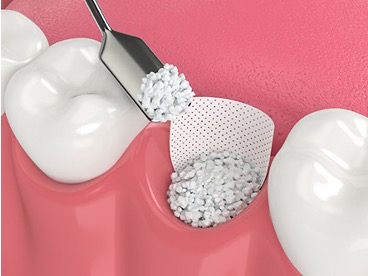If you are missing teeth, chances are good that you are exploring all your replacement options. You may have discussed dental implants with your general dentist, but have been told that your dental bone is too weak to support an implant.
Don’t give up there!
Dr. Pete is a skilled oral surgeon with advanced training in procedures like bone grafting, which can restore health and density to your bone. At Lakeside Implant & Oral Surgery, we make use of high-tech digital imaging and the latest advanced techniques to strengthen targeted areas of your jawbone and prepare your mouth for restoration after tooth extraction. Through bone grafting, you can become a much better candidate for a secure and stable dental implant.
 Bone Grafting Explained
Bone Grafting Explained
Bone grafting, also called regenerative surgery, uses granulated material in a specific area of the body to promote new bone growth. In oral surgery, bone grafting rebuilds bone in the jaw and is a common first step for many dental implant patients. The goal of bone grafting is to encourage the body to rebuild the bone and other structures that attach a tooth to the jaw.
When a tooth is missing and not replaced, the loss does not stop at the tooth. Over time, the bone underneath deteriorates. While many patients with varying degrees of bone loss are candidates for dental implants, those with insufficient bone may require a bone graft to rebuild the lost bone and successfully support an implant.
First, Dr. Pete will separate the gums from your teeth in order to gain access to the roots and bone. The roots will be thoroughly cleaned, and the holes in the bone will be filled with a graft material that usually consists of your own bone. After this process is completed, your gums will be put back in place and stitched together. Over the next few months, the grafted material will be encouraged to grow, which will fill in for lost bone and soft tissue.
The bone grafting material is sourced from a bank (donor bone), and all organic components are removed, leaving just the calcium behind. Dr. Pete will review your options, including your options for anesthesia, during your consultation appointment.
Ridge Augmentation
A common use of bone grafting is for ridge augmentation. Ridge augmentation can recapture the natural contour of your gums and jaw after the loss of a tooth as a result of trauma, congenital anomalies, infection, or periodontal disease. Achieving an ideal amount of gum and bone as a support to surrounding restorations or implants may require hard and soft tissue reconstruction. After the loss of one or more teeth, your gums and jawbone may become indented where the tooth or teeth used to be. This occurs because the jawbone recedes when it no longer is holding a tooth in place. Not only is this indentation unnatural looking, it also causes the replacement tooth to look too long compared to the adjacent teeth, and this can create an area that is difficult to keep clean.
Ridge augmentation uses bone and tissue-grafting procedures to fill in the indented area of the jaw and gums, leaving you with a smooth gum line that coexists with your restoration or dental implant.
Tissue Grafting
Depending on your specific needs, Dr. Pete will perform one of three different types of gum tissue grafts.
Connective tissue grafts – The most common method to treat root exposure, connective tissue grafting involves your oral surgeon cutting a flap of skin on the roof of your mouth (or palate) and removing tissue from under the flap, called sub-epithelial connective tissue. This tissue is then stitched to the gum tissue surrounding the exposed root. After the connective tissue, or graft, has been removed from under the flap, the flap is then stitched back down.
Free gingival grafts – Similar to a connective tissue grafting, a free gingival graft involves the use of tissue from the roof of the mouth. But instead of making a flap and removing tissue under the top layer of flesh, a small amount of tissue is removed directly from the roof of the mouth and then attached to the gum area being treated. This method is used most often in people who have thin gums to begin with and need additional tissue to enlarge the gums.
Pedicle grafts – In this procedure, instead of taking tissue from the palate, it is grafted from gum around or near the tooth needing repair. The flap, called a pedicle, is only partially cut away so that one edge remains attached. The gum is then pulled over or down to cover the exposed root and sewn into place. This procedure can only be done if you have plenty of gum tissue near the tooth.
Comfort and Recovery after Your Treatment
Depending on the extent of your bone graft, your recovery can take anywhere between two weeks and three months. During this time, it is normal to experience some soreness and discomfort. To maintain your comfort, Dr. Pete may suggest OTC pain medication like Tylenol® or ibuprofen, along with antibiotics to help reduce the risk of infection.
Following your bone graft procedure, Dr. Pete will provide a list of aftercare instructions that foster optimal healing and recovery. This list will include what you can and cannot eat after the surgery, how long you must avoid strenuous exercise, steps for keeping the bone graft area clean and dry, and other helpful information.
One of the most critical aftercare recommendations is to avoid smoking. Smoking will slow your body’s healing ability and affect your recovery timeline.
DETERMINING WHICH TREATMENTS ARE RIGHT FOR YOU
- Lakeside Implant & Oral Surgery performs the full scope of bone grafting procedures. Every case is different. You will have different needs based on a multitude of factors, including your age, the location and size of the tooth we are replacing, and your overall oral health. This is why it pays to discuss your options with a skilled oral surgeon like Dr. Pete.
- Dr. Pete will complete a thorough oral evaluation and assess your bone quality and facial structure with X-rays and 3D imaging. He will apply his expertise and experience to your case and lay out all your options as well as what you can expect from each one. One of our goals is to enhance your understanding of your oral health so you can make informed decisions about your care.
- We know you have a lot of questions and that you might be feeling worried about upcoming oral surgery. Dr. Pete has chosen his team carefully, combining the perfect mix of skill and compassion, and we are here to help you have the best possible oral surgery experience.
Please call our office today to schedule your consultation with Dr. Pete so you can learn more about your options.

